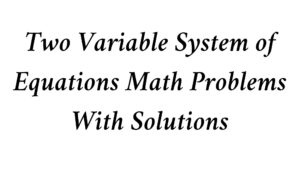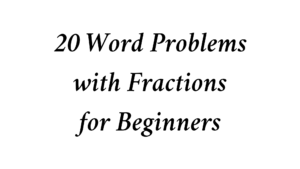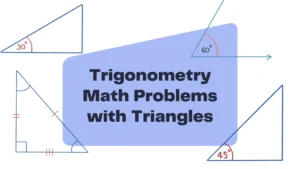I’ve included ten word problems for two variable linear equation systems in this article. The problems involve the application of a system of equations in money, events, exams, ages, and a variety of other topics. This article is excellent for students in middle and high schools.
Shopping or Selling Word Problems
Problem 1: Jose went to a fruit shop and bought 3 kg of apples and 2 kg of mangos for $11. Anna went to the same shop and bought 4 kg of mangos and 1 kg of apples for $7.
- What is the cost of 1 kg of apples?
- What is the cost of 2 kg of mangos?
- Sara went shopping and purchased 2 kg of apples and 2 kg of mangos; how much did she need to spend?
- How many apples can John buy if he has $10?
- There are 50 kg of apples and 30 kg of mangoes in the shop; how much money will the shopkeeper make after selling all the fruits?
Answer: Let a be the cost for 1 kg of apples and m is the cost for 1 kg of mangos.
Case 1) Jose bought 1kg of apples and 4 kg of mangos for $11
3a + 2m = 11………………….…….eq(1)
Case 2) Anna bought 3kg of apples and 2kg of mangos for $7
a + 4m = 7………..………………….eq(2)
Now multiply equation 1 with 2 (then the coefficient of m becomes 4)
(3a + 2m) × 2 = 11 × 2
⇒ 6a + 4m = 22…………………….….eq(3)
Subtract equation 2 from equation 3
6a + 4m – (a + 4m) = 22 – 7
⇒ 5a = 15
⇒ a = 3
So we got the cost of the apple is $3. Now substitute an in equation 2, then
a + 4m = 3 + 4m = 7
⇒ 4m = 4
⇒ m = 1
The cost of the mango is $1
- Cost of 1 kg of apple = a = $3
- Cost of 1 kg of mangos = 2 × m = $2
- Sara’s total spend = 2 × a + 2 × m = 2 × 3 + 2 × 2 = $10
- John’s apple : 15/a = 15/3 = 5 kg. So Jhon can buy 5 kg of apples for $15
- Shopkeeper earnings = 50 × a + 30 × m = 50 × 3 + 30 × 1 = $180
Problem 2: Selin is a farmer, Monday He sold 3kg of carrots and 8 kg of potatoes for $19. The next day, the price of potatoes and carrots increased by one dollar, and he sold 5 kg of carrots and 4 kg of potatoes for $22. Find the price of the carrots and potatoes on Monday
Answer: On Monday, assume the carrot price is c, and the potato price is p.
Case 1) Monday: 3c + 8p = 19………….…….eq(1)
Case 2) On Tuesday
Price of carrot = c + 1
Price of potato = p +1
Tuesday: 5(c + 1) + 4(p + 1) = 22
5c + 5 + 4p + 4 = 22
5c + 4p = 13……………….eq(2)
Multiply equation 2 with 2
(5c + 4p) × 2 = 13 × 2
⇒ 10c + 8p = 26……………………….eq(3)
Subtract equation 1 from equation 3
10c + 8p – (3c + 8p) = 26 – 19
⇒ 7c = 7
⇒ c = 1
Put c = 1 in equation 1
3 + 8p = 19
⇒ 8p = 16
⇒ p = 2
The price of the carrots on Monday = c = $2
The price of the potatoes on Monday = p = $1
Problem 3: Sharon’s father came with apples and oranges. However, four apples are more than oranges. He and his sister divided them equally, then they both received three times more apples than oranges. So, how many apples and oranges does Sharon’s father bring?
Answer: Lets the number of apples be x and the number of oranges be y
x – y = 4………………..…..eq(1)
When divided, Sharon and his sister get x/2 apples and y/2 oranges, and the number of apples = 3 × the number of oranges
x/2 = 3 × y/2
⇒ x = 3y…………………..eq(2)
From equation 1 and equation 2
3y – y = 4
⇒ 2y = 4
⇒ y = 2
From equation 2
x = 3 × 2 = 6
So, Sharon’s father brought 2 oranges and 6 apples
Age Word Problems
Problem 4: Kevin’s age is three times Sara’s age, and the difference between them is 8. Find the age of Kevin and Sara
Answer: Let k is Kevin’s age and s is Sara’s age
Case 1) Kevin’s age is three times Sara’s age: s = 3k
Case 2) The difference between ages is 8: s – k = 8
We can solve these equations using substitution
s – k = 8
⇒ 3k – k = 8
⇒ 2k = 8
⇒ k = 4
s = 3k = 3 × 4 = 12
So, Sara’s age is 12, and Kevin’s age is 4
Problem 5: Tomy’s age is five times that of his son. After six years, it will be three times bigger.
- Find Tomy and his son’s age after 5 years.
- How long it takes to become Tomy’s age is two times his son’s age
Answer: Let Tommy’s age is t and son’s age be s
Case 1) Tomy’s age is five times that of his son’s age: t = 5s
Case 2) Tomy’s age after six years = t + 6
Son’s age after six years = s + 6
t + 6 = 3(s + 6)
⇒ t + 6 = 3s + 18
Now substitute t = 5s, then
5s + 6 = 3s + 18
⇒ 2s = 12
⇒ s = 6
t = 5s = 5 × 6 = 30
- Tomy’s age after 5 years = t + 5 = 30 + 5 = 35
Son’s age after 5 years = s + 5 = 6 + 5 = 11
- Let’s assume, Tommy needs x years to reach two times his son’s age.
Tomy’s age after x years = t + x = 30 + x
Tomy’s son’s age after x years = s + x = 6 + x
30 + x = 2(6 + x)
⇒ 30 + x = 12 + 2x
⇒ x = 18
So Tommy needs 18 years to reach two times his son’s age
Interest and Banking Word Problems
Problem 6: Selin received $18,000 in loans from two banks. In bank A, the interest rate is 6% and in bank B, the interest rate is 7%. She must pay $1150 in interest at the end of the year. How much money did she borrow from each bank?
Answer: Let’s Selin’s loan from bank A = a and Selin’s loan from bank B = b
Case 1)
Total amount: a + b = 18000………………..eq(1)
Case 2)
Interest payment of bank A = (6/100) × a = 6a/100
Interest payment of bank A = (7/100) × b = 7b/100
6a/100 + 7b/100 = 1150
⇒ 6a + 7b = 115000………………..eq(2)
Multiply equation 1 with 6
(a + b) × 6 = 18000 × 6
⇒ 6a + 6b = 108000………………..eq(3)
Subtract equation 3 from equation 2
6a + 7b – (6a + 6b) = 115000 – 108000
⇒ b = 7000
From equation 1
a + 7000 = 18000
⇒ a = 11000
Selin borrowed $11000 from bank A and $7000 from bank B
Problem 7: Jo deposits $10000 into two accounts, one paying 6% and the other paying 9% simple interest each year. The amount of his annual interest is $882. What was her investment in each rate?
Answer: Lets Jo’s deposit in the 6% account = a and Jo’s deposit in the 9% account = b
Case 1)
Total amount: a + b = 10000………………..eq(1)
Case 2)
Interest of 6% account = (6/100) × a = 6a/100
Interest of 9% account = (9/100) × b = 9b/100
6a/100 + 9b/100 = 882
⇒ 6a + 9b = 88200………………..eq(2)
Multiply equation 1 with 6
(a + b) × 6 = 10000 × 6
⇒ 6a + 6b = 60000………………..eq(3)
Subtract equation 3 from equation 2
6a + 9b – (6a + 6b) = 88200 – 60000
⇒ 3b = 28200
⇒ b = 9400
From equation 1
a + 9400 = 10000
⇒ a = 600
Selin invested $9400 in the 9% account and invest $600 in the 6% account
Events
Problem 8: Tony hosted a special event, which cost $3 for children and $5 for adults. The event was attended by a total of 100 participants. Tony receive $420 after the event. How many children and adults participated in the event?
Answer: Assume that the number of children attending the event is a and the number of adults attending the event is b.
Case 1)
Total participants: a + b = 100………………eq(1)
Case 2)
Total money: 3a + 5b = 420…………….……eq(2)
Multiply equation 1 with 3, then
(a + b) × 3 = 100 × 3
⇒ 3a + 3b = 300…………….………………….…eq(3)
Subtract equation 3 from equation 2
3a + 5b – (3a + 3b) = 420 – 300
⇒ 2b = 120
⇒ b = 60
Plugin b = 60 in equation 1
a + 60 = 100
⇒ a = 40
So, 40 children and 60 adults participated in the event
Problem 9: There are 12 more boys than girls in a math class. If three girls are absent, the number of boys doubles. Then find the number of boys and girls
Answer: Lets the number of boys be b and the number of girls is g
Case 1)
b – g = 12……………………eq(1)
Case 2)
If three girls are absent, the number of girls = g – 3
Then, the number of boys = b = 2(g – 3)
⇒ b = 2g – 6
⇒ 2g – b = 6……………………eq(1)
Add equation 1 and equation 2
b – g + 2g – b = 12 + 6
⇒ g = 18
Plug in g = 18 in equation 1
b – 18 = 12
⇒ b = 30
That is the number of boys in the math class is 30 and the number of girls is 18
Problem 10: In a competitive exam, receives 4 points for right answers and loses 1 point for each wrong answer. Anna had 54 right answers but only received 200 points.
- How many answers are attended by Anna?
- Jhon answered all the questions, and he got half of them right and half of them wrong. Determine the total number of questions in the exam when he received 150 points.
Answer: Assume Anna attended x questions but answered y questions incorrectly.
Number of right answers = 54 = x – y
⇒ x = 54 + y
Anna’s points = (the number of the right answers × 4) – (number of the wrong answers × 1)
⇒ 200 = (54 × 4) – (y × 1)
⇒ 200 = 216 – y
⇒ y = 16
Then, x = 54 + 16 = 70
So Anna attended 70 questions
Let the total number of questions in the exam = 2z, then the number of right answers = the number of wrong answers = z
4z – z = 150
⇒ 3z = 150
⇒ z = 50
Total number of questions in the exam = 2z = 100



